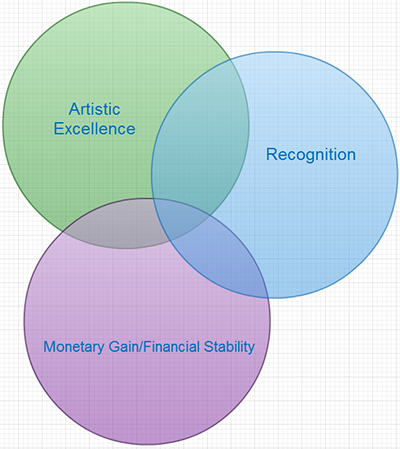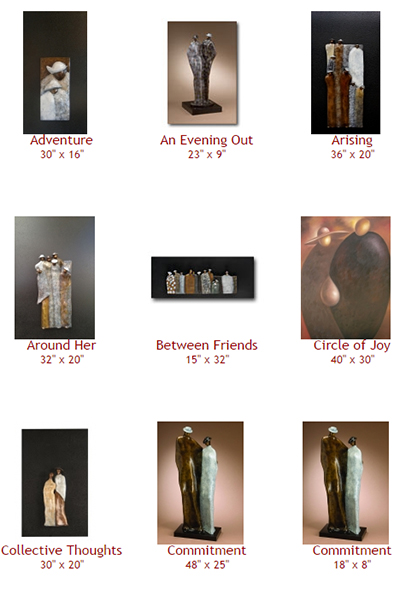
 I’ve had the privilege of working with and observing artists for a long time. As a gallery owner, I’ve been particularly interested in watching the careers of artists who have built strong sales of their work. These artists are able to generate sales that allow them to devote all of their time to their art. They have found ways to make a successful living while at the same time pursuing their passion.
I’ve had the privilege of working with and observing artists for a long time. As a gallery owner, I’ve been particularly interested in watching the careers of artists who have built strong sales of their work. These artists are able to generate sales that allow them to devote all of their time to their art. They have found ways to make a successful living while at the same time pursuing their passion.
Today I would like to share some of the strategies I’ve observed these artists following to achieve this level of success. Before I begin, however, I would like to take a brief moment to introduce myself. My name is Jason Horejs. I founded Xanadu Gallery in Scottsdale, Arizona in 2001, and I established RedDotBlog in 2008 as a forum where I could share my experiences and insights in the art business with artists and gallerists.
A successful fine art career depends on many factors. The strategies I will share here are certainly not the only ones that are important for an artist to consider, but these core strategies will have a huge impact on your success. I invite you to consider these factors and to explore the other posts on the blog. If you find this information helpful, sign up for our mailing list to receive free updates in your inbox that will help you build a better art business.
Strategy #1: Successful Artists Define what Success Means to Them
Before we can even begin talking about how an artist can build a successful career, I understand that the definition of success can vary dramatically from one artist to the next.
For some artists, success has nothing to do with money. Success for these artists can come from the satisfaction of creating work that is unique and innovative. Other artists enjoy the thrill of sharing their talents with others and the adulation they receive for their work. These artists seek the intangible benefits that come by sharing their creativity.
I’ve developed this venn diagram to help illustrate the different motivations that can drive an artist.

I see three key areas that can motivate an artist to create: artistic excellence, recognition and financial stability. As you can see in the diagram, the three can overlap. The greatest success can come to an artist who achieves a balance of all three, but achieving success in all three areas can take a lifetime.
Determining where your motivation lies will help you prioritize your efforts. For example, an artist who is focussing on artistic excellence may put all of her effort into studio work. She may spend very little time attempting to expose or sell her work. This artist may have to find other ways to subsist – taking jobs on the side to survive and buy supplies.
For an artist who is pursuing recognition, the priorities will be different. No artist creates in a vacuum, and many would argue that no work is complete until it has been shared with an audience. Many artists hunger for the opportunity to share their work. Art is communication at a very emotional and elemental level.
For some artists, the prospect of an award or critical praise of their work is more important than any monetary gain that might come from the sale of the work.
Finally, for some artists, I’ll call them entrepreneurial artists, it feels most natural to focus on creating work that will appeal to a broad audience. These artists align their passion and sales efforts and focus not only on creating, but also on getting work in front of potential buyers.
Determining your underlying motivation can help you direct your efforts for exposing your work. If artistic excellence is most important to you, you may focus on sharing your work only to mentors, critics and museums – you might not even try to sell the work.
Artist’s interested in recognition might focus on applying to shows and on achieving signature status with national artist societies. Again, sales may not be the highest priority.
An artist is who is seeking to build a business of his or her artistic work, will pursue opportunities to sell artwork. Art festivals and gallery representation might be the highest priority.
Only you can decide what success means to you. As a gallery owner, my focus is on selling artwork, and so my post today is going to center on principles that have helped artists become more successful in selling their work. I want, however, to acknowledge that sales are not the only worthy goal for an artist. With that said, this post is directed to artists who wish to sell more work.
It’s also important to point out that achieving success in any of the three areas listed above takes time and tremendous effort. An artist should be prepared to work hard and make sacrifices in order to achieve success.
Implementing this Strategy
Decide what your primary motivation is using the venn diagram. Your motivation will help you set your priorities.
Strategy #2: Successful Artists Dedicate Regular Time to Production

As I mentioned above, building a successful career as an artist takes time and hard work. A lot of time and a lot of work.
If there’s one common trait I’ve seen among successful artists, it’s that they aren’t afraid to work. Successful artists are dedicated to their creative efforts. The are consistently and constantly in the studio producing.
Selling art is a numbers game. In order to generate steady sales, you need to have your work in front of a large number of potential buyers in a variety of venues (more on this below). In order to sustain multiple venues, you have to have a strong, large body of work.
Ultimately, the best way to achieve this is to pursue your art full time. The vast majority of successful artists I’ve met over the years had taken the plunge to produce their art full time before they found financial success in their career.
I understand that pursuing art full time is a tremendous challenge, and sometimes the demands of life and family commitments won’t allow an artist to leave steady employment to pursue art full time.
Does this mean an artist who can’t work full time on art should give up on the dream of a successful art career? Not at all. I would encourage you to look at your available time and to set a schedule that allows you to both create and meet your other commitments. Carve out specific, regular time that you can dedicate to creating.
It will take a tremendous amount of discipline to create on weekends or after you have spent a long day at work. That discipline will be invaluable in helping you produce a body of salable art. The discipline you establish now will make you incredibly productive when you are able to take the leap and focus on your work full time.
Implementing this Strategy
Plot out your weekly schedule on a calendar or spreadsheet. Block out time that you can dedicate to your art.
Example Schedule – Part-Time Artist (Excel Spreadsheet Download)
Other considerations:
Share your schedule with family and friends, and ask them to help you protect your creative time. Tell them how important your art is to you – if you can get their buy-in, you are far more likely to stick to your schedule.
I’m often asked how many works of art an artist has to produce to be successful. This is a difficult question to answer because the number varies pretty dramatically from one artist to the next. I work with artists who produce over 100 pieces per year, and with artists who produce fewer than 30.
Some artists work quickly, but some art requires intensive detail. Instead of giving you a specific number to aim for, I encourage you to look over the last year and calculate the number of pieces you produced. Once you know how many works you produced during the last year, set a goal to increase your production in the next year by 25%.
Strategy #3: Create a Consistent Body of Artwork
As an artist, you are free to create whatever you want. You can pursue subject matter that captivates your imagination, and depict your subject in a style that excites you. I have found that artists who create work that they are passionate about are the most successful in the long run.
The challenge, especially for an artists who is in the early stages of an art career, is finding what it is you are passionate about. While some artists develop a clear artistic vision right away, most artists have to experiment and explore before discovering where their passion lies. Some artists will try their hand at various media as they are getting started, and others will explore a wide range of subjects and styles.
This exploration is healthy and necessary in an artist’s professional development. As an artist begins moving toward generating sales and building a professional career around his or her art, it becomes important that the artist begins focusing on a cohesive, identifiable body of work. If you look at the work of commercially successful fine artists, you will find that almost all of them have developed a recognizable style and have cultivated a consistency in their work that ties the work together.
This doesn’t mean that there can’t be some variety in your work, and it also doesn’t mean that you are going to spend the rest of your career producing the same artwork over and over and over. It simply means that if you want to successfully sell your work, you need to develop a style that your collectors can easily identify as yours.
When I look at an artist’s work for consistency, I use a simple, although admittedly subjective, metric that I use to judge consistency. I look at six criteria
- Subject Matter
- Style
- Theme
- Palette
- Medium
- Presentation
If the artist has achieved consistency in four of the six criteria across the work that is being presented to me, I will typically find the work to be consistent.
This means that you can have some latitude for variety in your work. If your subject, style, theme and palette are consistent, you can work in several different media with a variety of presentations. Conversely, if your medium, presentation, palette, style and presentation are consistent, you can explore a wide variety of subjects and themes.
Examples
Looking at several examples from among Xanadu Gallery artists we can see how consistency is achieved in a variety of ways.
Carolee Clark has a very consistent style, palette, theme and presentation, and all of her work is done in acrylic. This allows her to explore a range of subjects but still maintain consistency in her work.
Columbian born artist Guilloume creates both sculptures and paintings, but because his subject matter, style, theme, and palette are consistent, his variety in presentation and medium don’t interfere with his consistency.
Implementing this Strategy
Look at your last ten pieces and ask yourself how consistent they are in terms of the six consistency criteria. Determine which pieces are most consistent and strive to make your next ten pieces consistent with these works.
If you are having a hard time judging your consistency, bring an objective observer into your studio to look at the work for consistency. Ideally this would be someone who has some experience in the art world – a fellow artist whose work you admire, a gallerist or an interior designer.
Are you finding this information helpful? Sign up for our mailing list to receive art business advice from Xanadu Gallery Owner, Jason Horejs

Strategy #4: Organize your Business
 This strategy may be the least exciting to read about, but organization is critical to the long term success of your art business. If your goal is to make sales, or if your ambition is to make a living from your art, you will need to view your art-making as a business.
This strategy may be the least exciting to read about, but organization is critical to the long term success of your art business. If your goal is to make sales, or if your ambition is to make a living from your art, you will need to view your art-making as a business.
Some artists find this idea distasteful. They may feel that art and business don’t mix, and that introducing business into the equation may somehow taint the purity of their art.
I would encourage you to look at it a different way. Building a well-run, well-organized business around your art will allow you to avoid the disarray and frustration that surrounds many artists as their work begins to sell. By being organized you actually free yourself to focus on creating.
The artists I work with are very organized about the business end of their art. They’ve implemented systems that allow them to keep track of all of the moving parts of their art business.
The most important areas to focus on are:
- Inventory Tracking
- Accounting
- Shipping/Logistics
- Marketing
In other posts on this blog, I’ve shared some of the tools we use to organize our business, as well as tools artists are using. Every artist is going to have different business needs and will find different tools that will work best for meeting those needs. The important thing is to make a commitment to organizing these key areas so that you can scale up your business as sales increase.
It’s also important to note that a number of the artists I have worked with over the years recognize that organization is not their strong suit. These artists have brought in assistants to help them tackle the business. Sometimes the assistant will be a spouse or other family member. For other artists, hiring someone to come into the studio several times a week to help is a better option.
Implementing this Strategy
Evaluate your current ability to track your artwork, your finances and your shipping. Do you have robust systems and routines in place that allow you to track your business activity?
Make a list of the requirements of any system that would make it ideal for tracking your business. This list of requirements will help you evaluate potential tools.
Strategy #5: Diversify your Sales by Showing your Work in Multiple Venues
Successful artists understand that in order to sell art, the art has to receive massive exposure. To a certain extent, art sales is a numbers game. In order to find buyers who will be interested in your work and in a financial position to purchase. In order to reach those buyers, you need to have your artwork on display in a variety of venues.
The successful artists I’ve worked with over the years have all worked very hard to put their work in front of potential buyers. Many started their careers by participating in outdoor art festivals and shows. Art shows are an opportunity not only to display and sell work, but an opportunity for you to build your contact list and develop salesmanship skills.
Successful artists also look for other opportunities to sell their work. In addition to art festivals, many of these artists have participated in art organizations that host open studio tours and put on other shows.
Ultimately, many successful artists have approached galleries with their work. Building relationships with galleries gives artists something that shows or personal promotion can’t, constant, long-term exposure backed by a professional sales staff.
Most successful artists are not only showing in one gallery, they are showing in a variety of galleries in diverse locations. Besides the broad exposure this strategy creates, showing in a variety of markets can help stabilize your sales. It’s often the case that if sales are down in one area, they may be up in another.
Implementing this Strategy
As you prepare to ramp up your art career, look for opportunities to show your work. Seek shows and venues that successfully attract qualified art buyers and have a track record of generating sales.
Prepare to present your work to galleries by creating a portfolio of consistent, high-quality work. Research various art markets and the galleries that serve those markets in order to find those galleries that would be the best fit for your work.
A Personal Invitation to Join Reddotblog.com
If you are ready to become more serious about pursuing your fine art career, I invite you to sign up for our free mailing list. Join our blog to receive free updates and art business posts. My posts include articles on every aspect of the art business and instructional videos that will provide detailed instructions to help you with the brass tacks of producing, promoting, marketing and selling your work.
There is no obligation when you join our mailing list – you can unsubscribe at any time. So join today and begin building a successful business around your passion!

J. Jason Horejs
Owner | Xanadu Gallery
Publisher | Reddotblog.com


